EX-99.1
Published on September 22, 2023

The PNC Financial Services Group Investor Meetings Third Quarter 2023 Exhibit 99.1
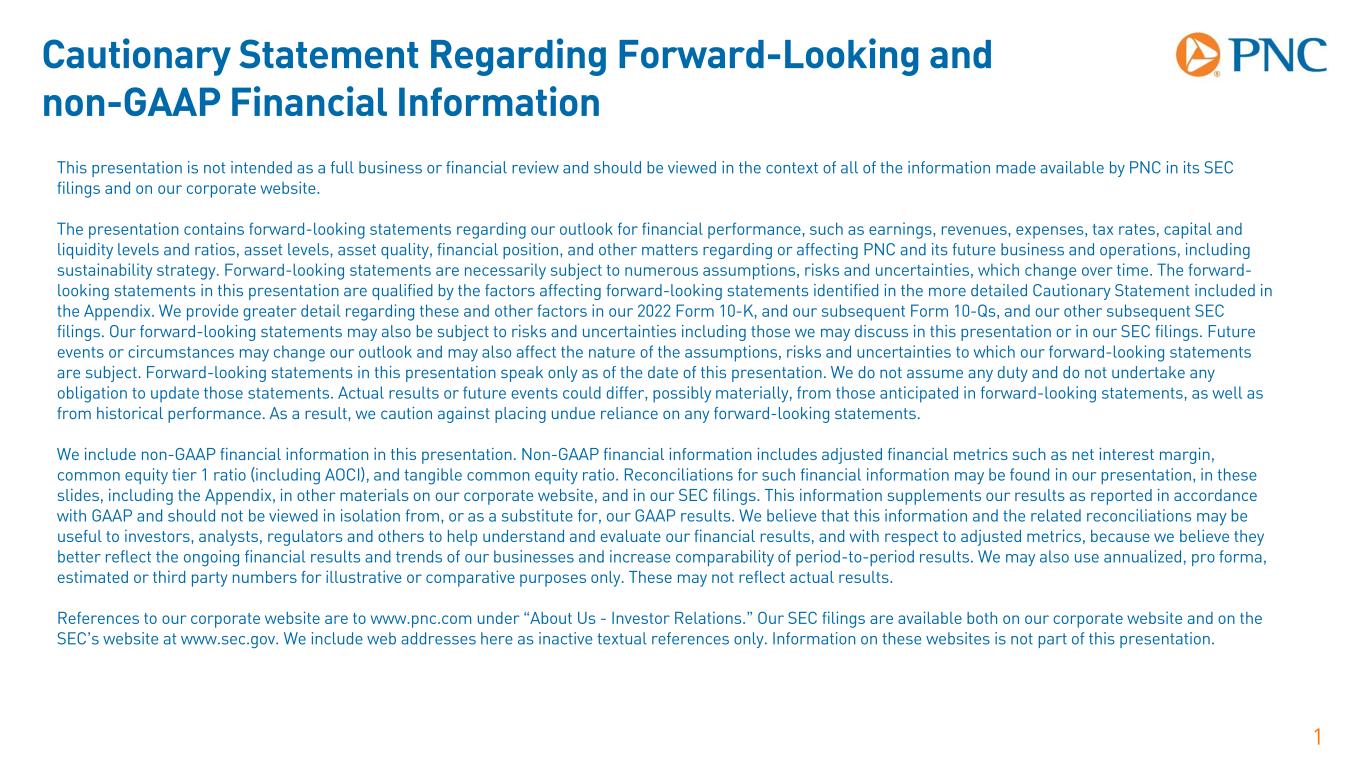
Cautionary Statement Regarding Forward-Looking and non-GAAP Financial Information This presentation is not intended as a full business or financial review and should be viewed in the context of all of the information made available by PNC in its SEC filings and on our corporate website. The presentation contains forward-looking statements regarding our outlook for financial performance, such as earnings, revenues, expenses, tax rates, capital and liquidity levels and ratios, asset levels, asset quality, financial position, and other matters regarding or affecting PNC and its future business and operations, including sustainability strategy. Forward-looking statements are necessarily subject to numerous assumptions, risks and uncertainties, which change over time. The forward- looking statements in this presentation are qualified by the factors affecting forward-looking statements identified in the more detailed Cautionary Statement included in the Appendix. We provide greater detail regarding these and other factors in our 2022 Form 10-K, and our subsequent Form 10-Qs, and our other subsequent SEC filings. Our forward-looking statements may also be subject to risks and uncertainties including those we may discuss in this presentation or in our SEC filings. Future events or circumstances may change our outlook and may also affect the nature of the assumptions, risks and uncertainties to which our forward-looking statements are subject. Forward-looking statements in this presentation speak only as of the date of this presentation. We do not assume any duty and do not undertake any obligation to update those statements. Actual results or future events could differ, possibly materially, from those anticipated in forward-looking statements, as well as from historical performance. As a result, we caution against placing undue reliance on any forward-looking statements. We include non-GAAP financial information in this presentation. Non-GAAP financial information includes adjusted financial metrics such as net interest margin, common equity tier 1 ratio (including AOCI), and tangible common equity ratio. Reconciliations for such financial information may be found in our presentation, in these slides, including the Appendix, in other materials on our corporate website, and in our SEC filings. This information supplements our results as reported in accordance with GAAP and should not be viewed in isolation from, or as a substitute for, our GAAP results. We believe that this information and the related reconciliations may be useful to investors, analysts, regulators and others to help understand and evaluate our financial results, and with respect to adjusted metrics, because we believe they better reflect the ongoing financial results and trends of our businesses and increase comparability of period-to-period results. We may also use annualized, pro forma, estimated or third party numbers for illustrative or comparative purposes only. These may not reflect actual results. References to our corporate website are to www.pnc.com under “About Us - Investor Relations.” Our SEC filings are available both on our corporate website and on the SEC’s website at www.sec.gov. We include web addresses here as inactive textual references only. Information on these websites is not part of this presentation. 1
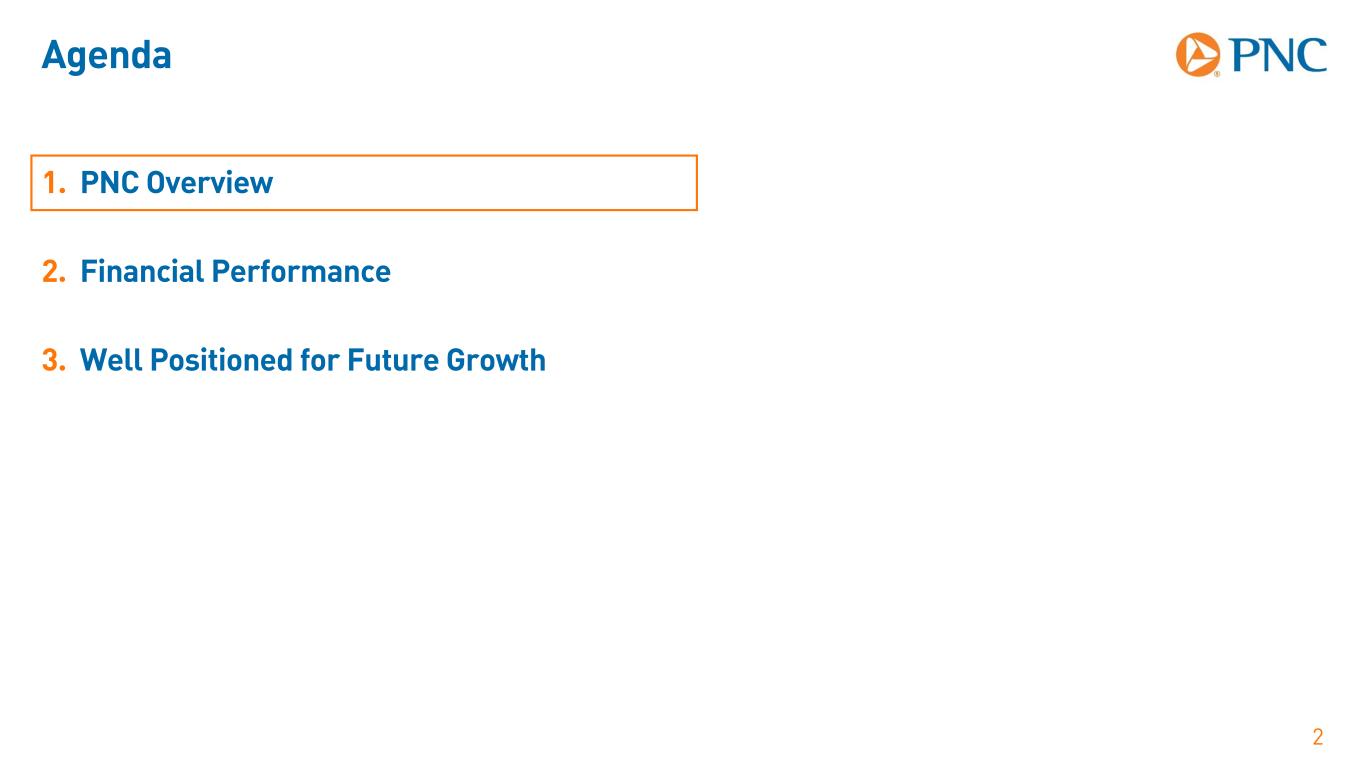
Agenda 1. PNC Overview 2. Financial Performance 3. Well Positioned for Future Growth 2
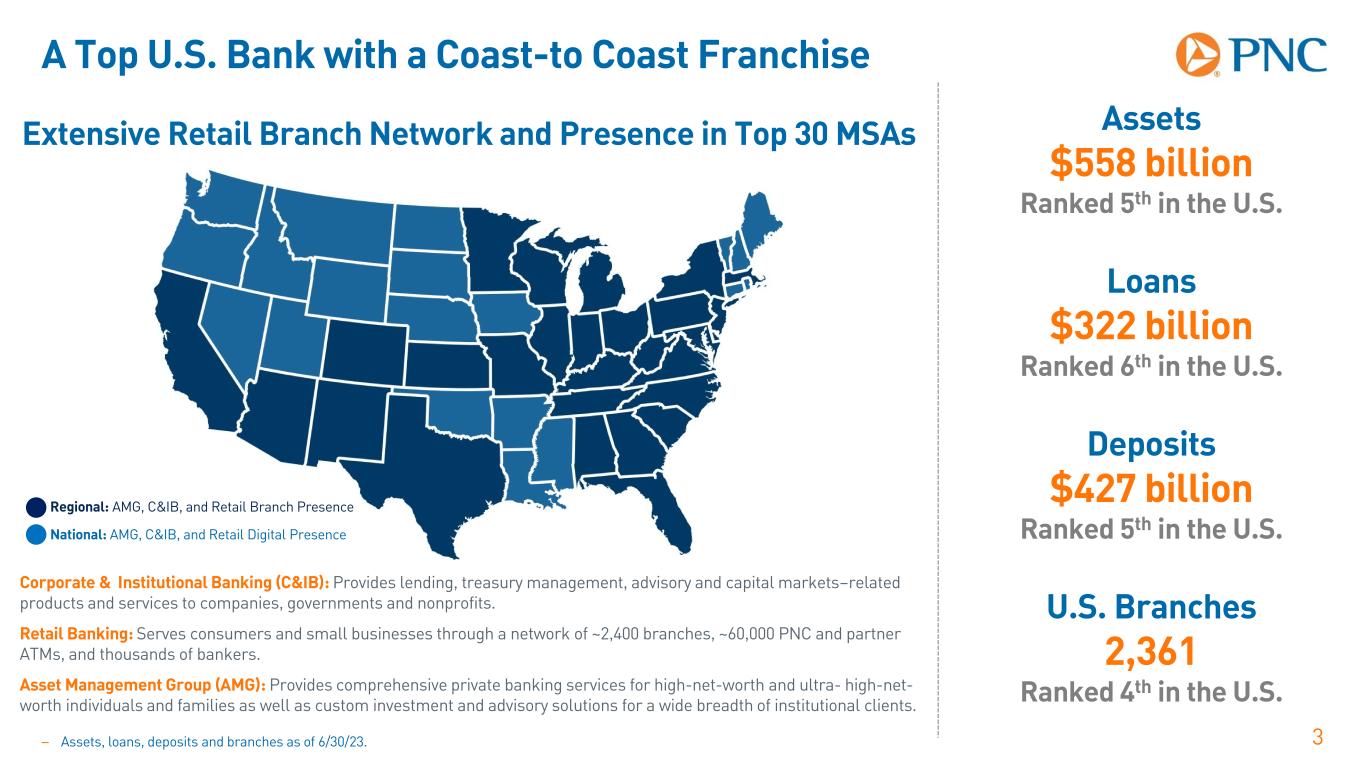
A Top U.S. Bank with a Coast-to Coast Franchise 3 Extensive Retail Branch Network and Presence in Top 30 MSAs National: AMG, C&IB, and Retail Digital Presence Regional: AMG, C&IB, and Retail Branch Presence Corporate & Institutional Banking (C&IB): Provides lending, treasury management, advisory and capital markets–related products and services to companies, governments and nonprofits. Retail Banking: Serves consumers and small businesses through a network of ~2,400 branches, ~60,000 PNC and partner ATMs, and thousands of bankers. Asset Management Group (AMG): Provides comprehensive private banking services for high-net-worth and ultra- high-net- worth individuals and families as well as custom investment and advisory solutions for a wide breadth of institutional clients. Assets $558 billion Ranked 5th in the U.S. Loans $322 billion Ranked 6th in the U.S. Deposits $427 billion Ranked 5th in the U.S. U.S. Branches 2,361 Ranked 4th in the U.S. – Assets, loans, deposits and branches as of 6/30/23.
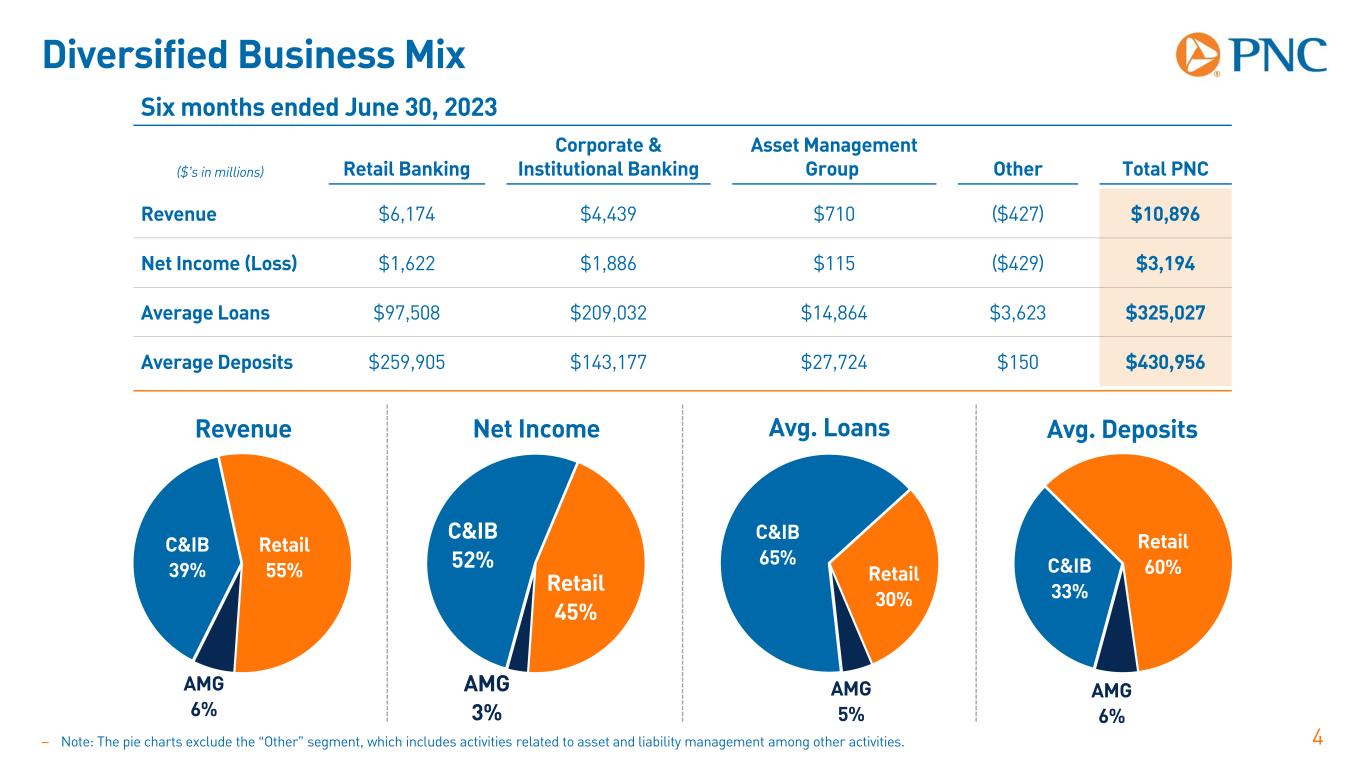
Diversified Business Mix 4– Note: The pie charts exclude the “Other” segment, which includes activities related to asset and liability management among other activities. AMG 6% C&IB 39% Retail 55% Revenue AMG 6% C&IB 33% Retail 60% Avg. Deposits AMG 5% C&IB 65% Retail 30% Avg. Loans AMG 3% C&IB 52% Retail 45% Net Income Six months ended June 30, 2023 ($’s in millions) Retail Banking Corporate & Institutional Banking Asset Management Group Other Total PNC Revenue $6,174 $4,439 $710 ($427) $10,896 Net Income (Loss) $1,622 $1,886 $115 ($429) $3,194 Average Loans $97,508 $209,032 $14,864 $3,623 $325,027 Average Deposits $259,905 $143,177 $27,724 $150 $430,956
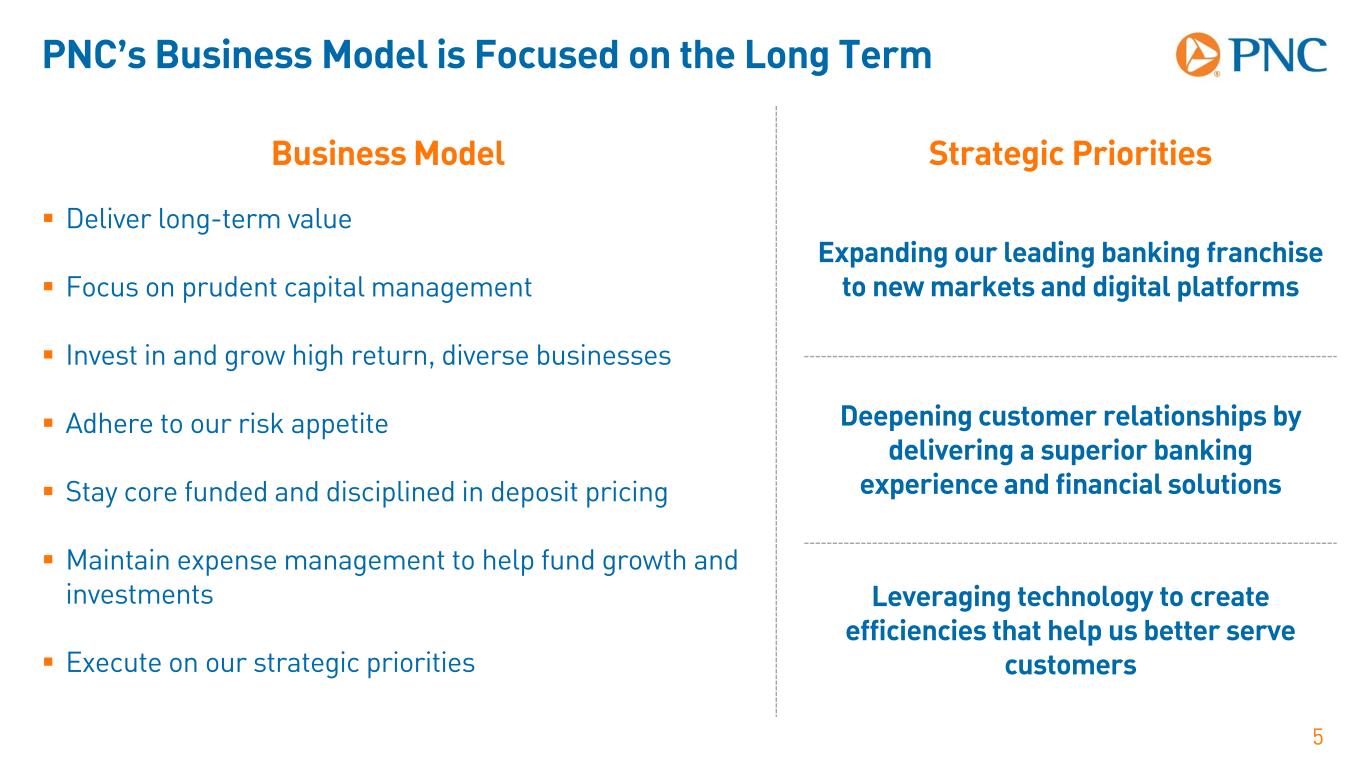
PNC’s Business Model is Focused on the Long Term Deliver long-term value Focus on prudent capital management Invest in and grow high return, diverse businesses Adhere to our risk appetite Stay core funded and disciplined in deposit pricing Maintain expense management to help fund growth and investments Execute on our strategic priorities 5 Business Model Strategic Priorities Expanding our leading banking franchise to new markets and digital platforms Deepening customer relationships by delivering a superior banking experience and financial solutions Leveraging technology to create efficiencies that help us better serve customers
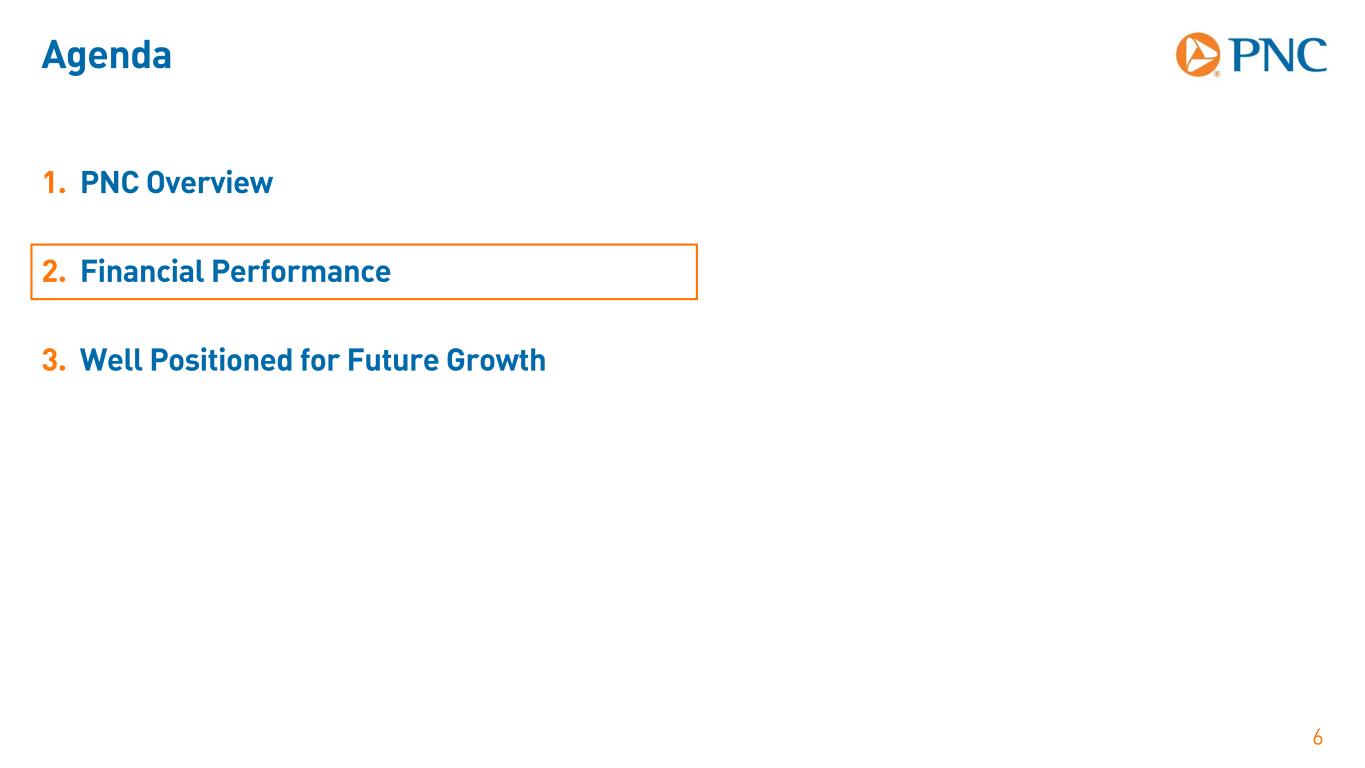
Agenda 1. PNC Overview 2. Financial Performance 3. Well Positioned for Future Growth 6

Delivered Strong First Half 2023 Results 7 Continued to execute on our strategic priorities Grew consumer households and commercial relationships Increased capital position Well-controlled expenses Maintained strong credit quality Improved Stress Capital Buffer to regulatory floor of 2.5% beginning in the fourth quarter of 2023 Increased quarterly dividend by $0.05 to $1.55, reflecting continued strong capital and liquidity levels Net Income $3.2 billion Diluted Earnings Per Share $7.34 Basel III CET 1 Capital Ratio 9.5% CET 1 Capital Ratio, Including AOCI (non-GAAP) 7.7% Net Charge-Off Ratio 0.24% − Net Charge-Off Ratio represents annualized net charge-offs (NCOs) to average loans for the six months ended June 30, 2023. − Basel III common equity Tier (CET) 1 capital ratio. Details of the calculation are in the capital ratios table in the financial highlights section of the earnings release. − AOCI represents accumulated other comprehensive income. − CET 1 Ratio, Including AOCI (non-GAAP) – See Reconciliation in Appendix. The ratio is estimated as of 6/30/23. Return on Average Common Shareholders' Equity 14.5%
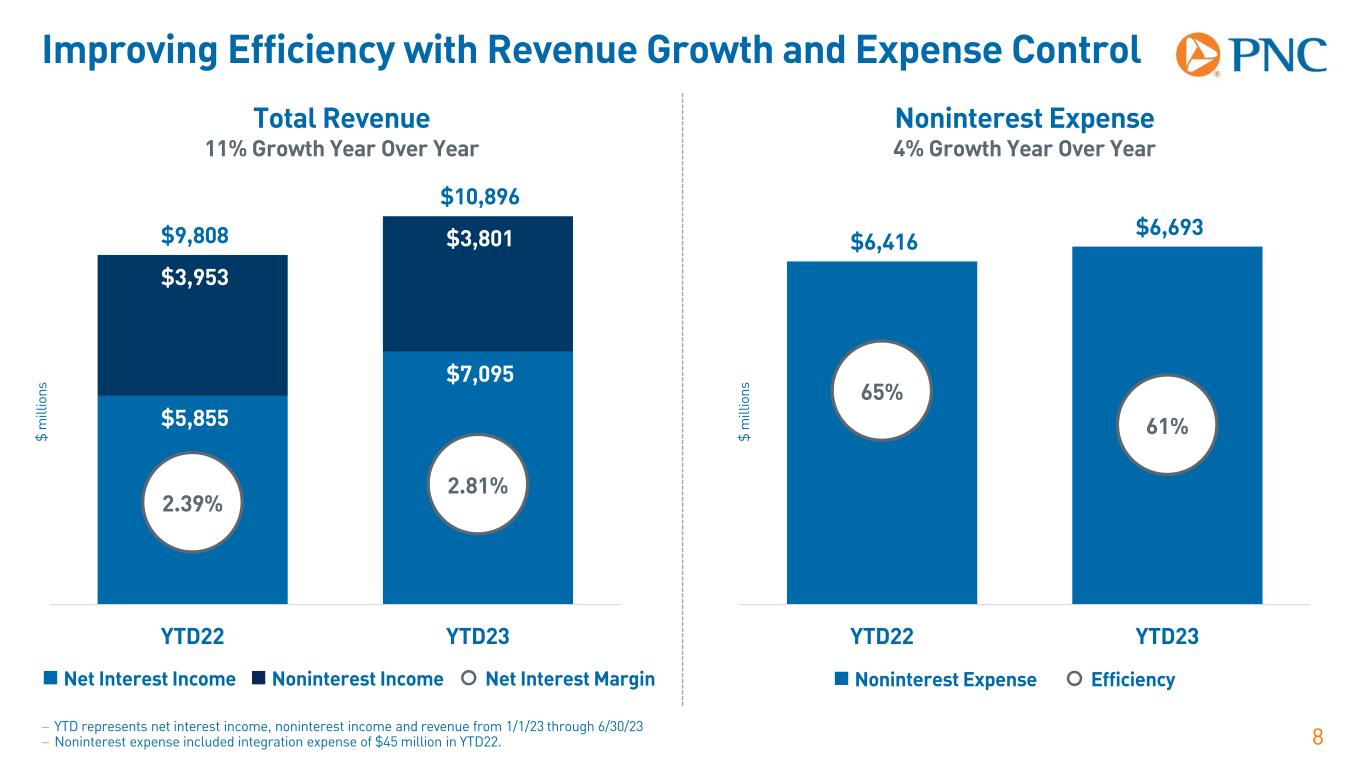
Improving Efficiency with Revenue Growth and Expense Control 8 $ m ill io ns Total Revenue 11% Growth Year Over Year $5,855 $7,095 $3,953 $3,801 $9,808 $10,896 2.39% 2.81% YTD22 YTD23 Noninterest Expense 4% Growth Year Over Year Net Interest Income Net Interest MarginNoninterest Income − YTD represents net interest income, noninterest income and revenue from 1/1/23 through 6/30/23 − Noninterest expense included integration expense of $45 million in YTD22. $6,416 $6,693 65% 61% YTD22 YTD23 Noninterest Expense Efficiency $ m ill io ns
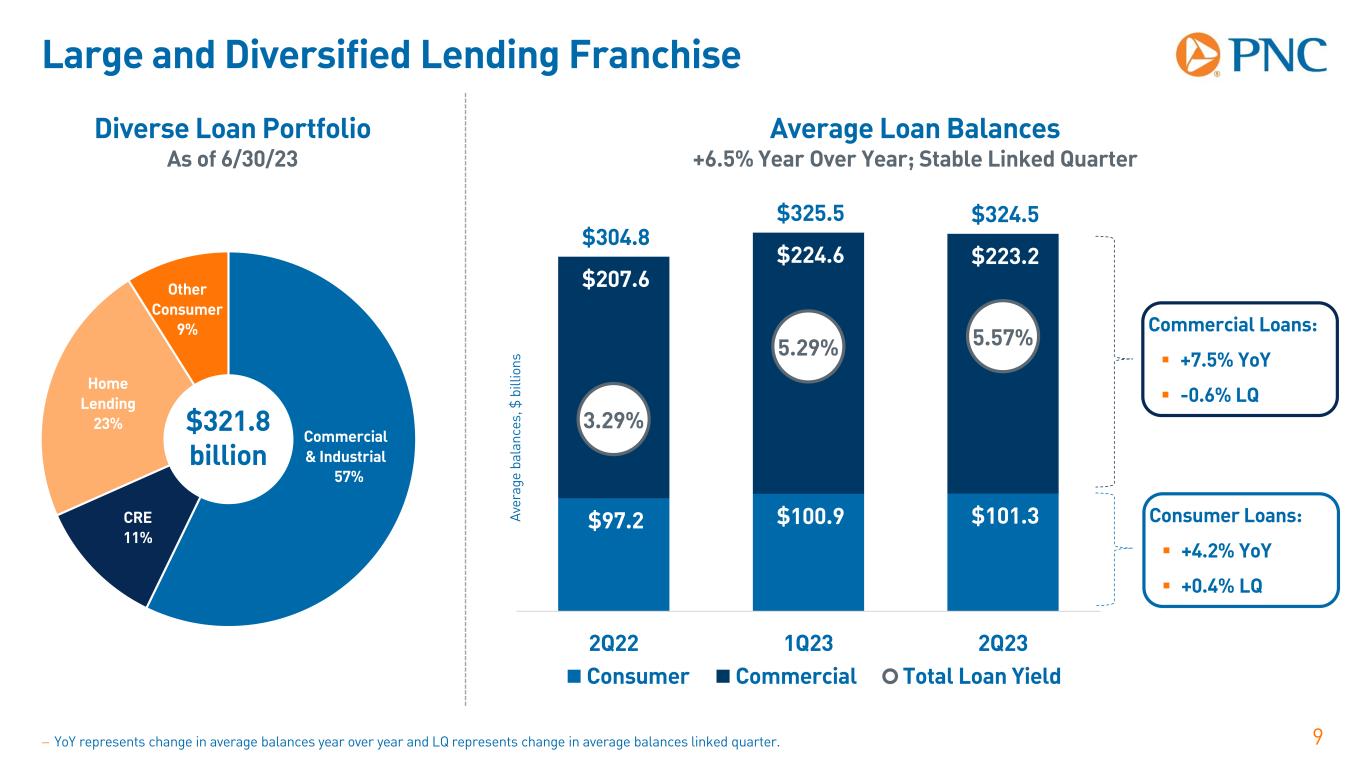
Large and Diversified Lending Franchise 9 Av er ag e ba la nc es , $ b ill io ns $97.2 $100.9 $101.3 $207.6 $224.6 $223.2 $304.8 $325.5 $324.5 3.29% 5.29% 5.57% 2Q22 1Q23 2Q23 Consumer Commercial Total Loan Yield − YoY represents change in average balances year over year and LQ represents change in average balances linked quarter. Commercial Loans: +7.5% YoY -0.6% LQ Consumer Loans: +4.2% YoY +0.4% LQ Average Loan Balances +6.5% Year Over Year; Stable Linked Quarter Commercial & Industrial 57% CRE 11% Home Lending 23% Other Consumer 9% $321.8 billion Diverse Loan Portfolio As of 6/30/23

Granular Deposit Base 10 Composition of Deposit Portfolio 54% of Total Deposits are Insured Total Deposits $427 Billion as of 6/30/23 Commercial Deposits $206 billion at 6/30/23 89% Insured 20% Insured 80% Uninsured Consumer Deposits $221 billion at 6/30/23 Granular Deposit Base ~$11,100 Average Account Balance Large Customer Base ~20 million Consumer Accounts Across our Coast-to-Coast Franchise 2,361 Branches − Relationship Accounts represent commercial deposit customers with at least one additional PNC product (e.g. Lending, Treasury Management, Capital Markets, Merchant Services, etc.). − TM Compensating Balances represent treasury management accounts that maintain balances that are used to offset treasury management fees. As of 6/30/23 Operating & Relationship Accounts: Relationship Accounts 71% TM Compensating Balances 19% Midland Escrow Accounts 5% Total Operating & Relationship Accounts 95% Deposit Only Accounts 5% Total # of Accounts 1.4 million
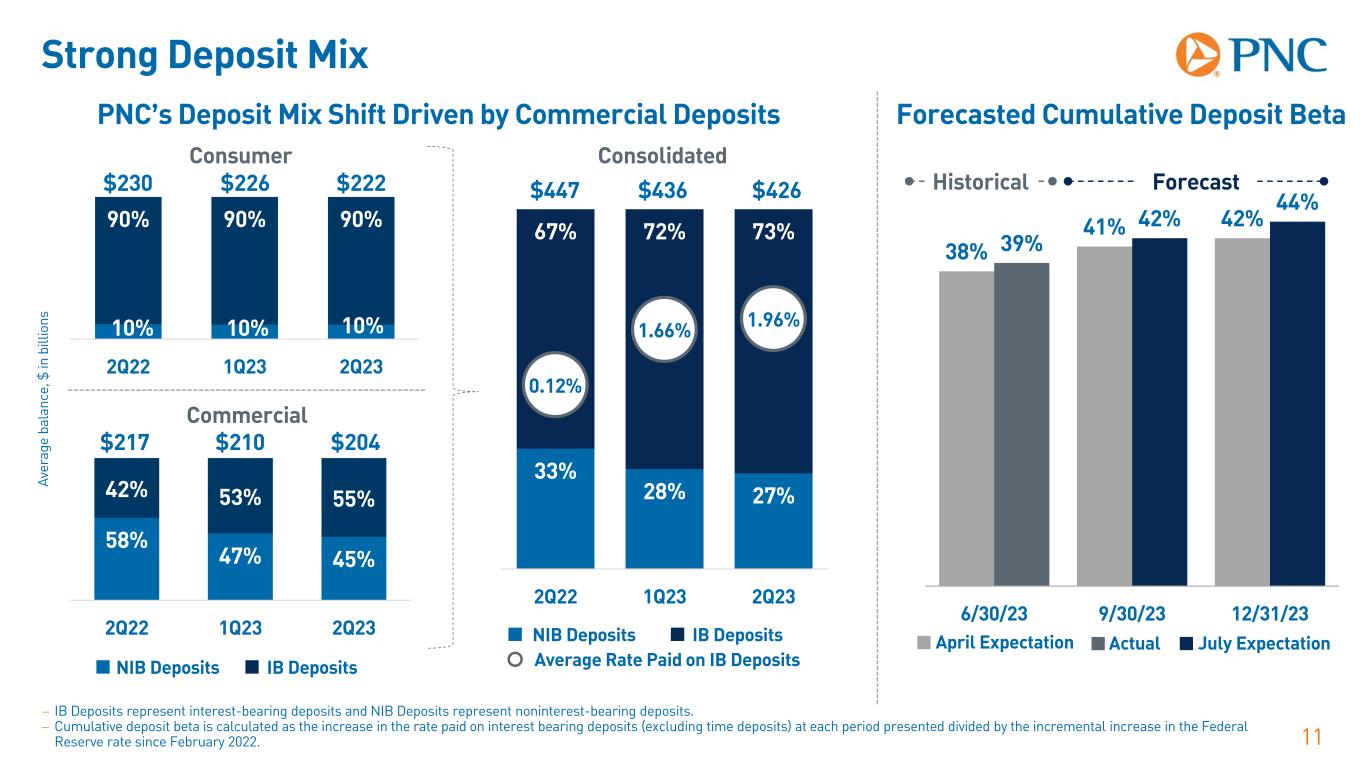
33% 28% 27% 67% 72% 73% 0.12% 1.66% 1.96% 2Q22 1Q23 2Q23 Strong Deposit Mix 11 − IB Deposits represent interest-bearing deposits and NIB Deposits represent noninterest-bearing deposits. − Cumulative deposit beta is calculated as the increase in the rate paid on interest bearing deposits (excluding time deposits) at each period presented divided by the incremental increase in the Federal Reserve rate since February 2022. PNC’s Deposit Mix Shift Driven by Commercial Deposits 10% 10% 10% 90% 90% 90% 2Q22 1Q23 2Q23 58% 47% 45% 42% 53% 55% 2Q22 1Q23 2Q23 Consumer Commercial Consolidated IB DepositsNIB Deposits IB DepositsNIB Deposits $230 $222 $217 $210 $447 $426 Av er ag e ba la nc e, $ in b ill io ns Forecasted Cumulative Deposit Beta $436$226 $204 Average Rate Paid on IB Deposits 38% 41% 42% 39% 42% 44% 6/30/23 9/30/23 12/31/23 Historical July ExpectationActualApril Expectation Forecast

High-Quality, Short-Duration Securities and Swaps 12 Average Securities Duration of 4.2 Years $134.7 $143.4 $141.0 1.89% 2.49% 2.52% 2Q22 1Q23 2Q23 $42.3 $41.7 $39.9 0.97% 1.48% 1.73% 6/30/22 3/31/23 6/30/23 Notional Receive-Fixed Swaps Duration of 2.3 Years Securities Balances Yield on Securities Swap Balances Receive Fixed Rate Sp ot b al an ce , $ in b ill io ns Av er ag e ba la nc e, $ in b ill io ns
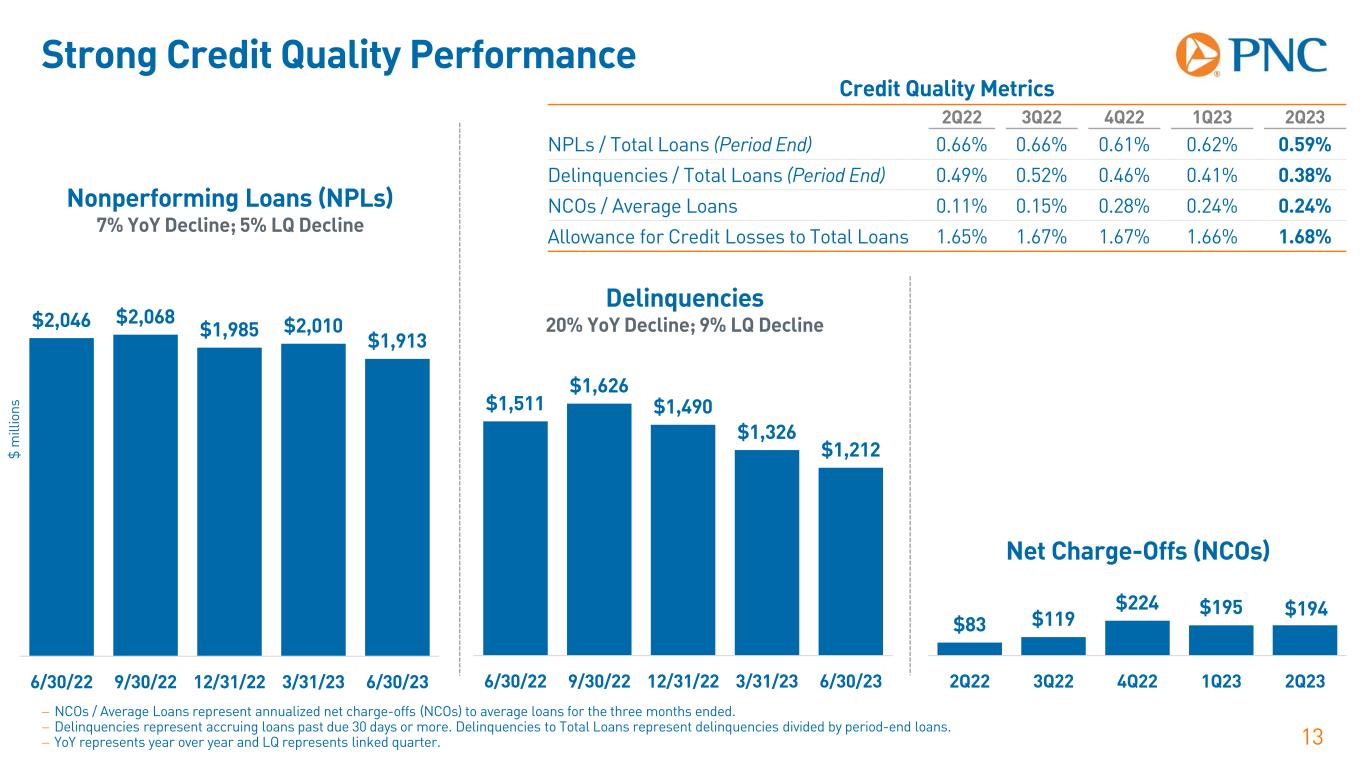
Strong Credit Quality Performance 13 − NCOs / Average Loans represent annualized net charge-offs (NCOs) to average loans for the three months ended. − Delinquencies represent accruing loans past due 30 days or more. Delinquencies to Total Loans represent delinquencies divided by period-end loans. − YoY represents year over year and LQ represents linked quarter. $1,511 $1,626 $1,490 $1,326 $1,212 6/30/22 9/30/22 12/31/22 3/31/23 6/30/23 $2,046 $2,068 $1,985 $2,010 $1,913 6/30/22 9/30/22 12/31/22 3/31/23 6/30/23 Nonperforming Loans (NPLs) 7% YoY Decline; 5% LQ Decline Delinquencies 20% YoY Decline; 9% LQ Decline Net Charge-Offs (NCOs) $194 $83 $119 $224 $195 2Q22 3Q22 4Q22 1Q23 2Q23 Credit Quality Metrics 2Q22 3Q22 4Q22 1Q23 2Q23 NPLs / Total Loans (Period End) 0.66% 0.66% 0.61% 0.62% 0.59% Delinquencies / Total Loans (Period End) 0.49% 0.52% 0.46% 0.41% 0.38% NCOs / Average Loans 0.11% 0.15% 0.28% 0.24% 0.24% Allowance for Credit Losses to Total Loans 1.65% 1.67% 1.67% 1.66% 1.68% $ m ill io ns

CRE Office Portfolio Represents 2.7% of Total Loans 14 Office Portfolio Multi-Tenant 57% Single- Tenant 16% Medical 14% Government 10% Other 3% $8.7 billion Geographic Diversification By Metropolitan Statistical Area Key Office Portfolio Metrics Conservative Underwriting Methodology Suburban 44% Central Business District 30% Medical 14% Diversified 8% Other 4% $8.7 billion Tenant Classification Market Type $ billions 6/30/23 Washington-Arlington-Alexandria $1.2 Los Angeles-Long Beach-Anaheim 1.1 Dallas-Fort Worth-Arlington 0.5 San Francisco-Oakland-Berkeley 0.4 Baltimore-Columbia-Towson 0.3 San Diego-Chula Vista-Carlsbad 0.3 Chicago-Naperville-Elgin 0.3 Philadelphia-Camden-Wilmington 0.3 Boston-Cambridge-Newton 0.3 Houston-The Woodlands-Sugar Land 0.2 Other 3.8 Total $8.7 ($ in millions) 6/30/23 3/31/23 Total Loans ($ in billions) $8.7 $8.9 Avg. Loan Commitment $35 $35 Reserves / Loans 7.4% 7.1% NCOs / Average Loans 1.4% 0.5% Delinquencies / Loans 0.0% 0.2% NPL / Loans 3.3% 3.5% Criticized Loans / Loans 22.5% 20.0% − Average Loan Commitment for PNC Real Estate − NCOs / Average loans represents net charge-offs to average loans for the last twelve month period − NPL represents Nonperforming Loans
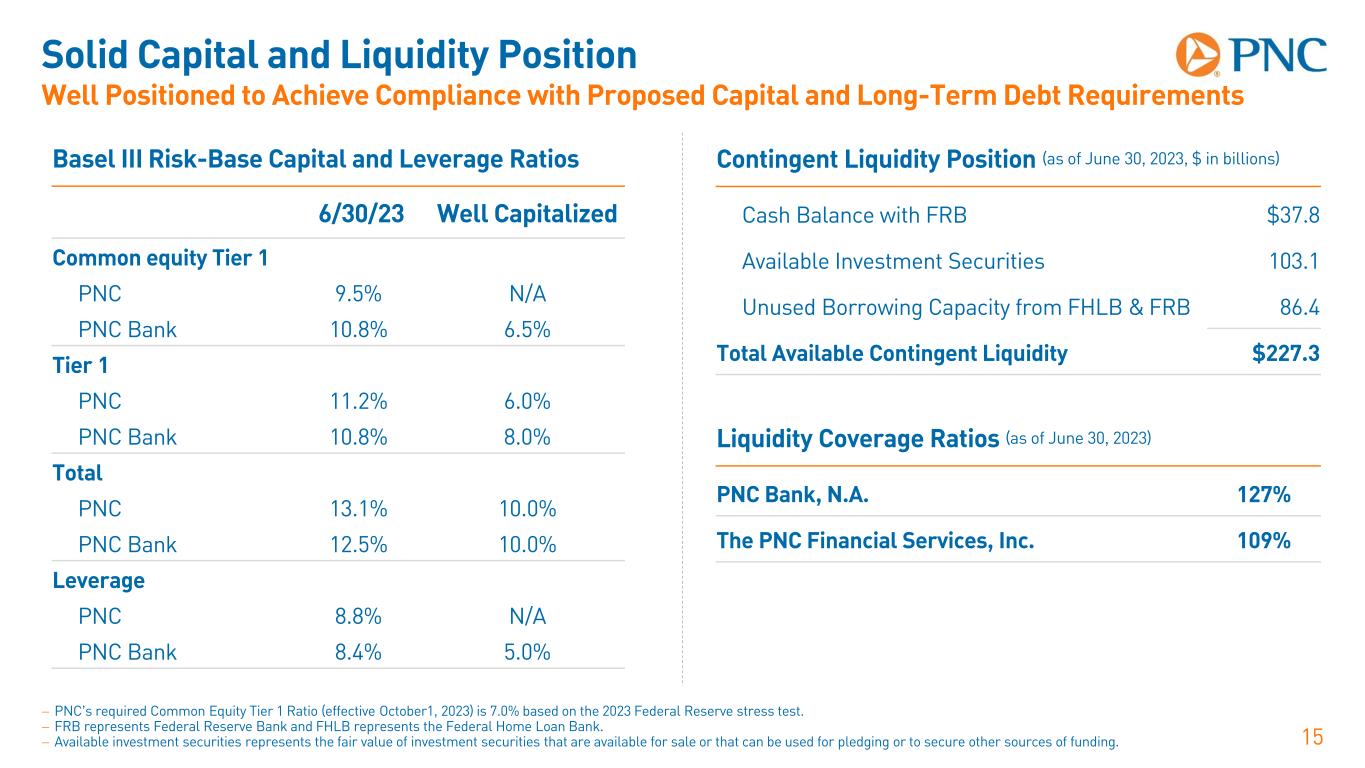
Solid Capital and Liquidity Position Well Positioned to Achieve Compliance with Proposed Capital and Long-Term Debt Requirements 15 − PNC’s required Common Equity Tier 1 Ratio (effective October1, 2023) is 7.0% based on the 2023 Federal Reserve stress test. − FRB represents Federal Reserve Bank and FHLB represents the Federal Home Loan Bank. − Available investment securities represents the fair value of investment securities that are available for sale or that can be used for pledging or to secure other sources of funding. Contingent Liquidity Position (as of June 30, 2023, $ in billions) Cash Balance with FRB $37.8 Available Investment Securities 103.1 Unused Borrowing Capacity from FHLB & FRB 86.4 Total Available Contingent Liquidity $227.3 Basel III Risk-Base Capital and Leverage Ratios 6/30/23 Well Capitalized Common equity Tier 1 PNC 9.5% N/A PNC Bank 10.8% 6.5% Tier 1 PNC 11.2% 6.0% PNC Bank 10.8% 8.0% Total PNC 13.1% 10.0% PNC Bank 12.5% 10.0% Leverage PNC 8.8% N/A PNC Bank 8.4% 5.0% Liquidity Coverage Ratios (as of June 30, 2023) PNC Bank, N.A. 127% The PNC Financial Services, Inc. 109%
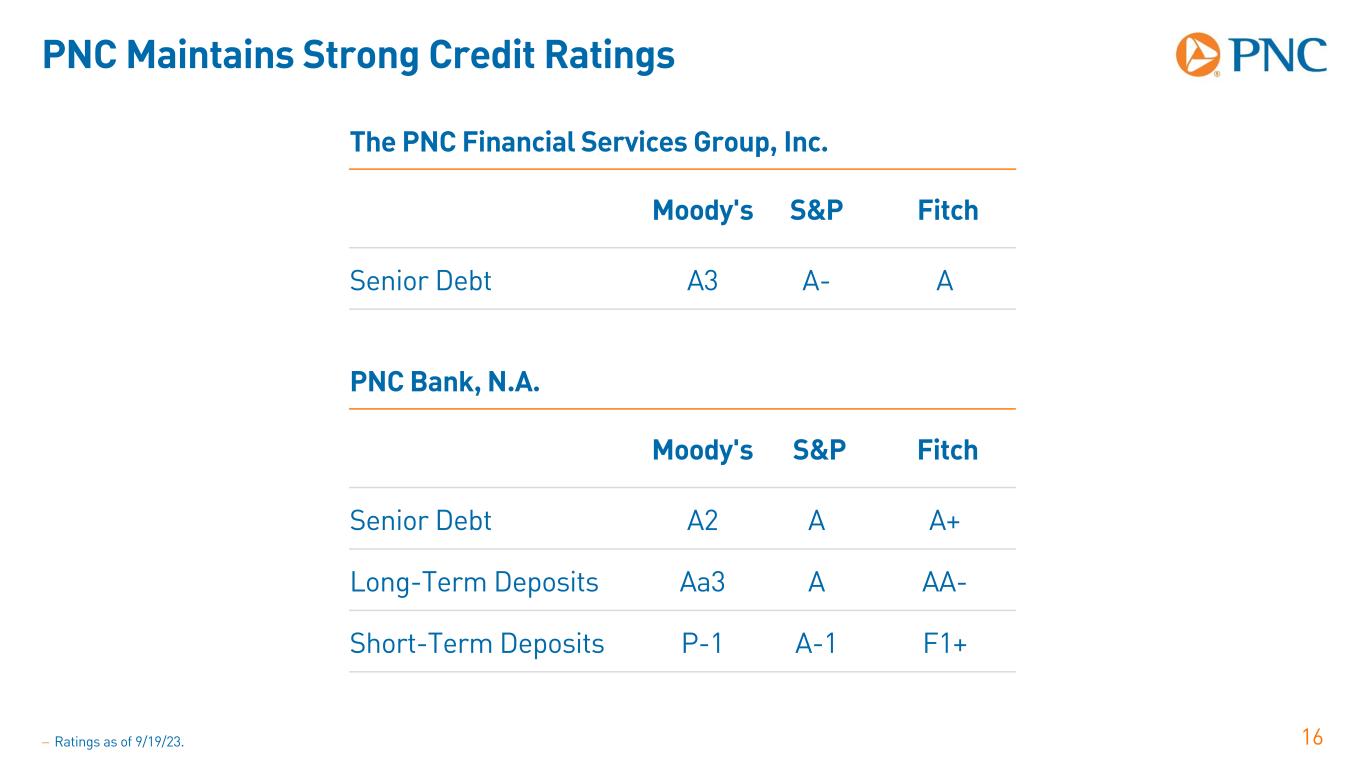
PNC Maintains Strong Credit Ratings 16 The PNC Financial Services Group, Inc. Moody's S&P Fitch Senior Debt A3 A- A PNC Bank, N.A. Moody's S&P Fitch Senior Debt A2 A A+ Long-Term Deposits Aa3 A AA- Short-Term Deposits P-1 A-1 F1+ − Ratings as of 9/19/23.
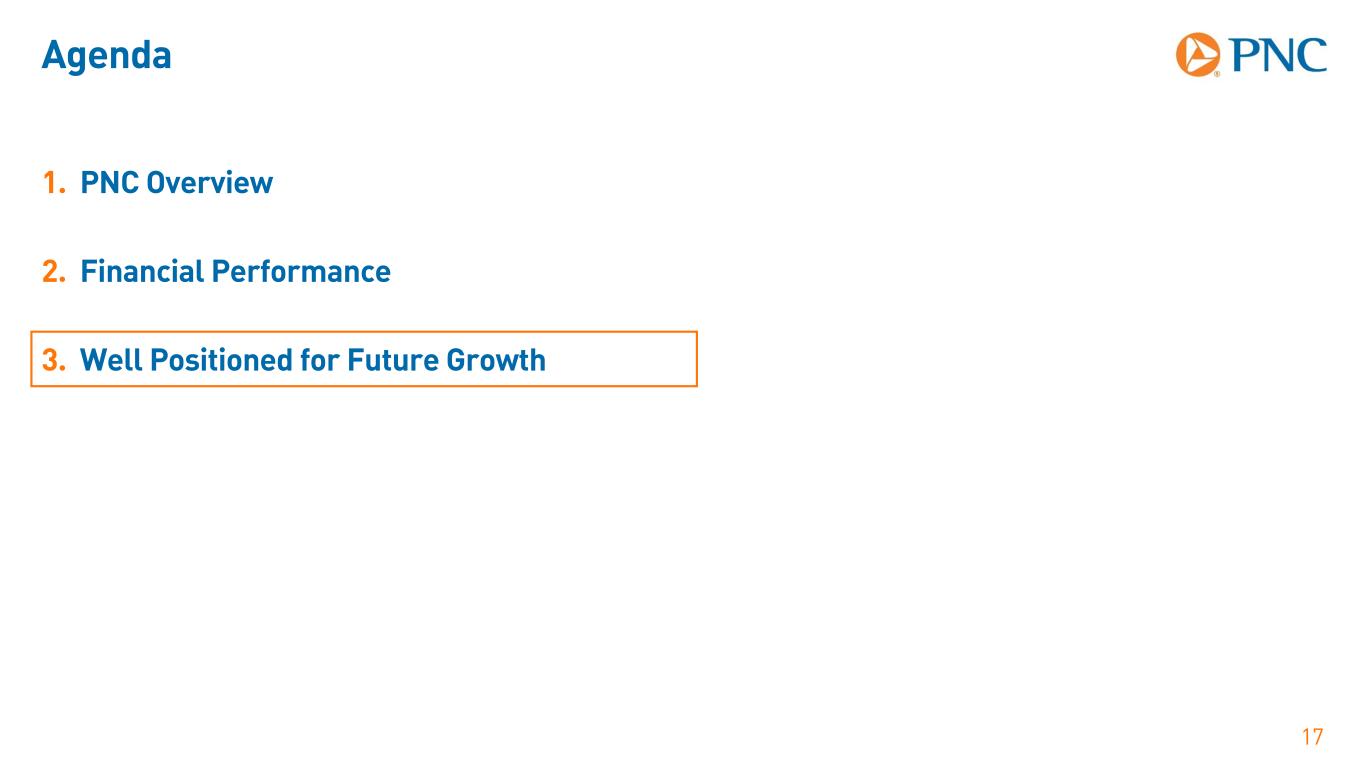
Agenda 1. PNC Overview 2. Financial Performance 3. Well Positioned for Future Growth 17
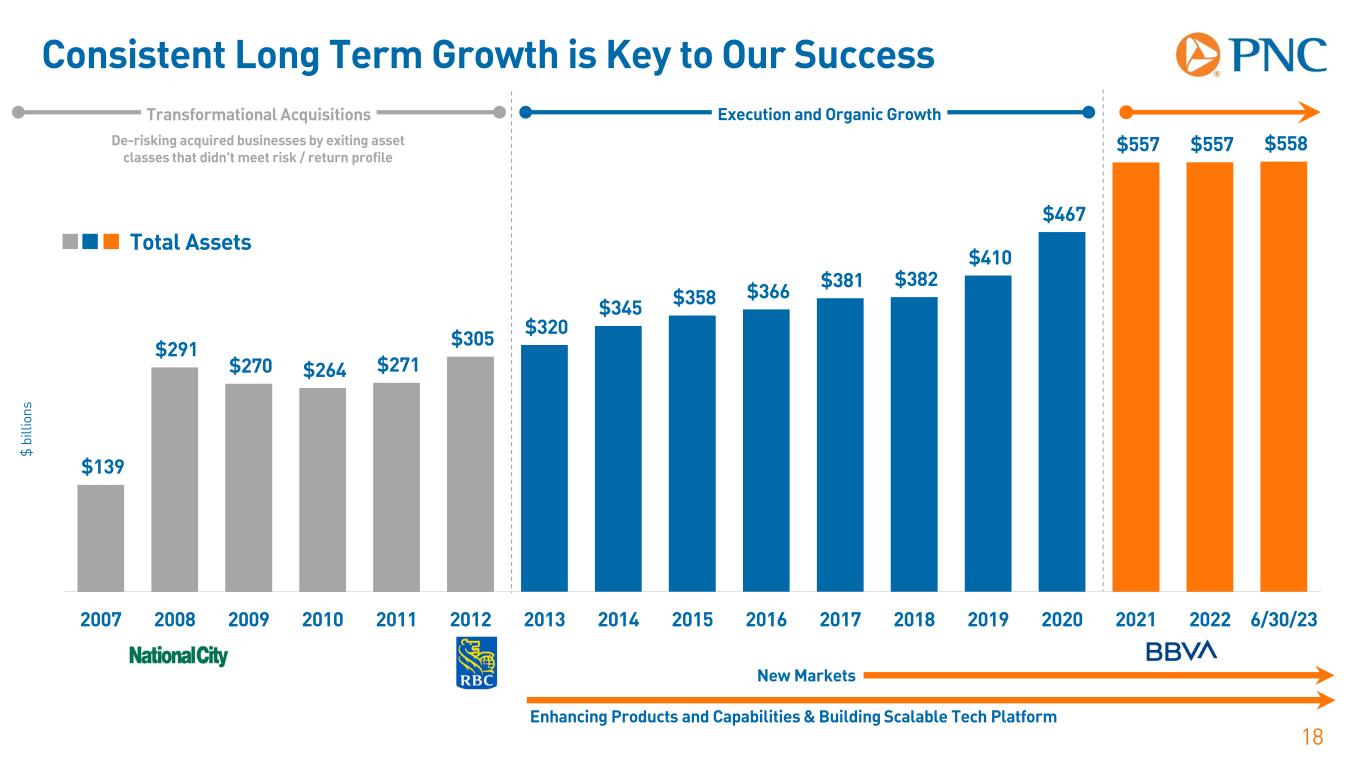
Consistent Long Term Growth is Key to Our Success $139 $291 $270 $264 $271 $305 $320 $345 $358 $366 $381 $382 $410 $467 $557 $557 $558 2007 2008 2009 2010 2011 2012 2013 2014 2015 2016 2017 2018 2019 2020 2021 2022 6/30/23 Enhancing Products and Capabilities & Building Scalable Tech Platform New Markets Transformational Acquisitions De-risking acquired businesses by exiting asset classes that didn't meet risk / return profile Execution and Organic Growth 18 $ bi lli on s Total Assets
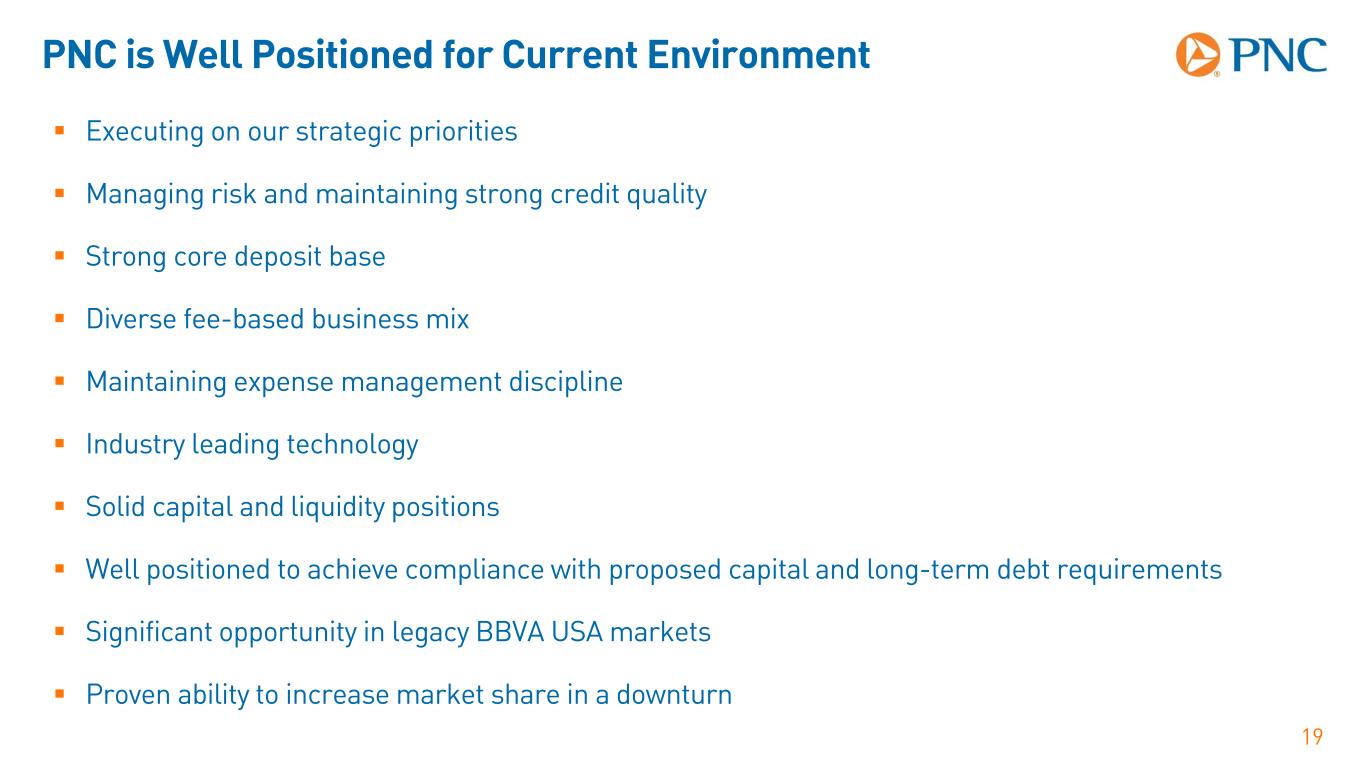
PNC is Well Positioned for Current Environment 19 Executing on our strategic priorities Managing risk and maintaining strong credit quality Strong core deposit base Diverse fee-based business mix Maintaining expense management discipline Industry leading technology Solid capital and liquidity positions Well positioned to achieve compliance with proposed capital and long-term debt requirements Significant opportunity in legacy BBVA USA markets Proven ability to increase market share in a downturn
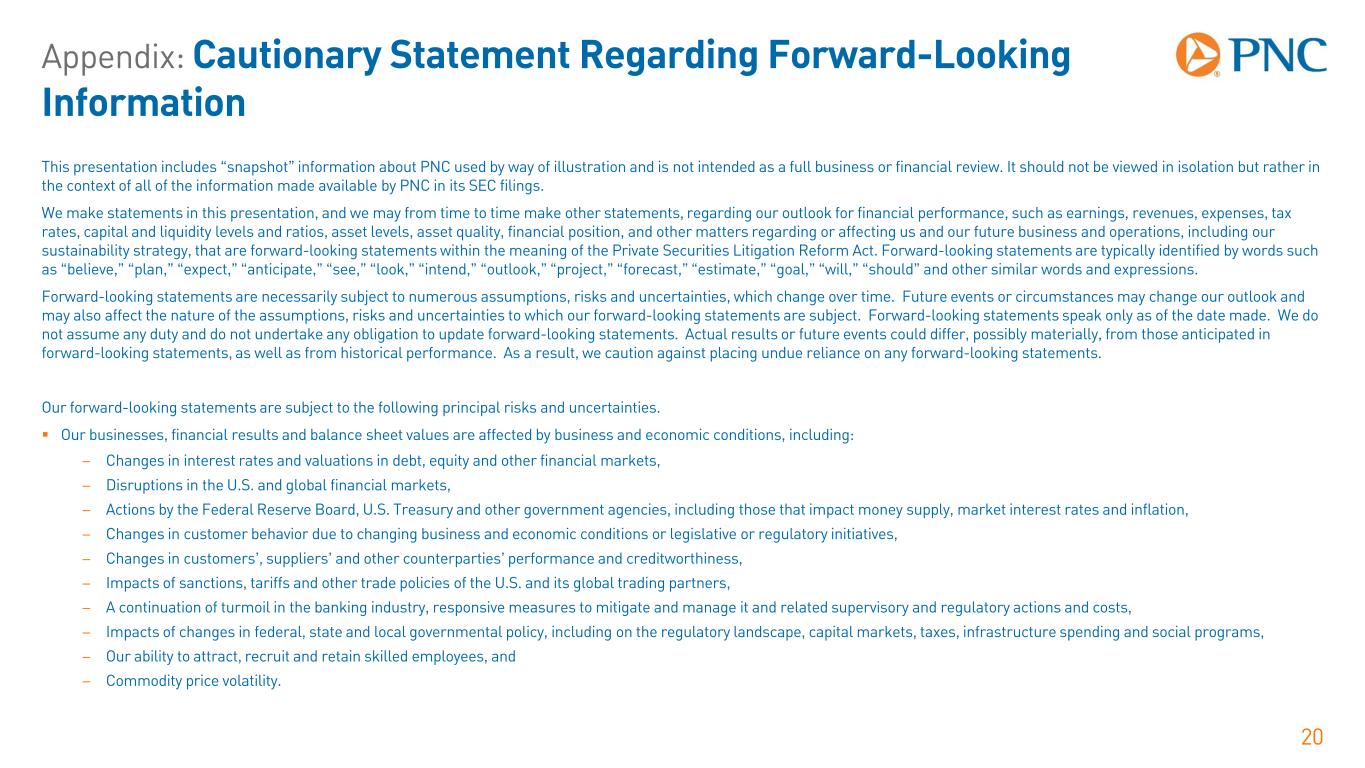
Appendix: Cautionary Statement Regarding Forward-Looking Information 20 This presentation includes “snapshot” information about PNC used by way of illustration and is not intended as a full business or financial review. It should not be viewed in isolation but rather in the context of all of the information made available by PNC in its SEC filings. We make statements in this presentation, and we may from time to time make other statements, regarding our outlook for financial performance, such as earnings, revenues, expenses, tax rates, capital and liquidity levels and ratios, asset levels, asset quality, financial position, and other matters regarding or affecting us and our future business and operations, including our sustainability strategy, that are forward-looking statements within the meaning of the Private Securities Litigation Reform Act. Forward-looking statements are typically identified by words such as “believe,” “plan,” “expect,” “anticipate,” “see,” “look,” “intend,” “outlook,” “project,” “forecast,” “estimate,” “goal,” “will,” “should” and other similar words and expressions. Forward-looking statements are necessarily subject to numerous assumptions, risks and uncertainties, which change over time. Future events or circumstances may change our outlook and may also affect the nature of the assumptions, risks and uncertainties to which our forward-looking statements are subject. Forward-looking statements speak only as of the date made. We do not assume any duty and do not undertake any obligation to update forward-looking statements. Actual results or future events could differ, possibly materially, from those anticipated in forward-looking statements, as well as from historical performance. As a result, we caution against placing undue reliance on any forward-looking statements. Our forward-looking statements are subject to the following principal risks and uncertainties. Our businesses, financial results and balance sheet values are affected by business and economic conditions, including: − Changes in interest rates and valuations in debt, equity and other financial markets, − Disruptions in the U.S. and global financial markets, − Actions by the Federal Reserve Board, U.S. Treasury and other government agencies, including those that impact money supply, market interest rates and inflation, − Changes in customer behavior due to changing business and economic conditions or legislative or regulatory initiatives, − Changes in customers’, suppliers’ and other counterparties’ performance and creditworthiness, − Impacts of sanctions, tariffs and other trade policies of the U.S. and its global trading partners, − A continuation of turmoil in the banking industry, responsive measures to mitigate and manage it and related supervisory and regulatory actions and costs, − Impacts of changes in federal, state and local governmental policy, including on the regulatory landscape, capital markets, taxes, infrastructure spending and social programs, − Our ability to attract, recruit and retain skilled employees, and − Commodity price volatility.
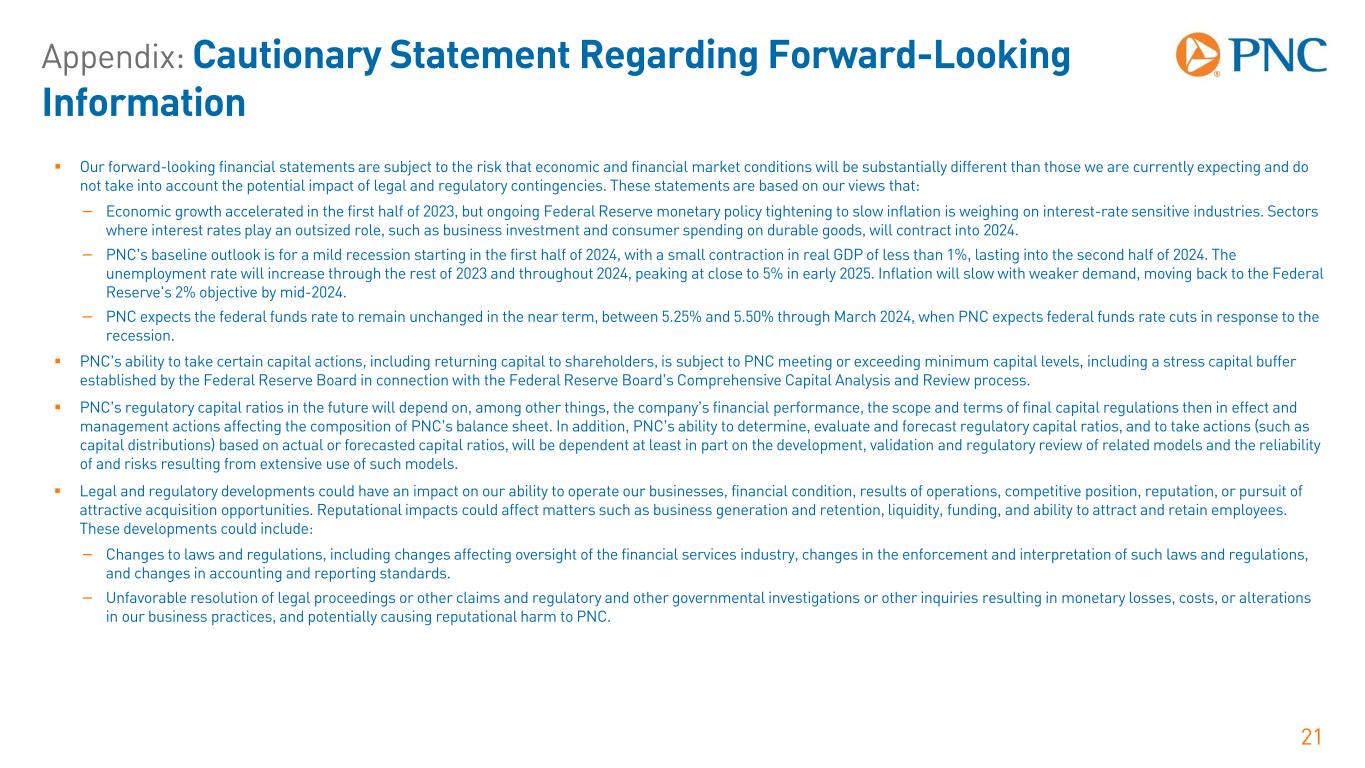
Appendix: Cautionary Statement Regarding Forward-Looking Information 21 Our forward-looking financial statements are subject to the risk that economic and financial market conditions will be substantially different than those we are currently expecting and do not take into account the potential impact of legal and regulatory contingencies. These statements are based on our views that: − Economic growth accelerated in the first half of 2023, but ongoing Federal Reserve monetary policy tightening to slow inflation is weighing on interest-rate sensitive industries. Sectors where interest rates play an outsized role, such as business investment and consumer spending on durable goods, will contract into 2024. − PNC’s baseline outlook is for a mild recession starting in the first half of 2024, with a small contraction in real GDP of less than 1%, lasting into the second half of 2024. The unemployment rate will increase through the rest of 2023 and throughout 2024, peaking at close to 5% in early 2025. Inflation will slow with weaker demand, moving back to the Federal Reserve's 2% objective by mid-2024. − PNC expects the federal funds rate to remain unchanged in the near term, between 5.25% and 5.50% through March 2024, when PNC expects federal funds rate cuts in response to the recession. PNC’s ability to take certain capital actions, including returning capital to shareholders, is subject to PNC meeting or exceeding minimum capital levels, including a stress capital buffer established by the Federal Reserve Board in connection with the Federal Reserve Board’s Comprehensive Capital Analysis and Review process. PNC’s regulatory capital ratios in the future will depend on, among other things, the company’s financial performance, the scope and terms of final capital regulations then in effect and management actions affecting the composition of PNC’s balance sheet. In addition, PNC’s ability to determine, evaluate and forecast regulatory capital ratios, and to take actions (such as capital distributions) based on actual or forecasted capital ratios, will be dependent at least in part on the development, validation and regulatory review of related models and the reliability of and risks resulting from extensive use of such models. Legal and regulatory developments could have an impact on our ability to operate our businesses, financial condition, results of operations, competitive position, reputation, or pursuit of attractive acquisition opportunities. Reputational impacts could affect matters such as business generation and retention, liquidity, funding, and ability to attract and retain employees. These developments could include: − Changes to laws and regulations, including changes affecting oversight of the financial services industry, changes in the enforcement and interpretation of such laws and regulations, and changes in accounting and reporting standards. − Unfavorable resolution of legal proceedings or other claims and regulatory and other governmental investigations or other inquiries resulting in monetary losses, costs, or alterations in our business practices, and potentially causing reputational harm to PNC.
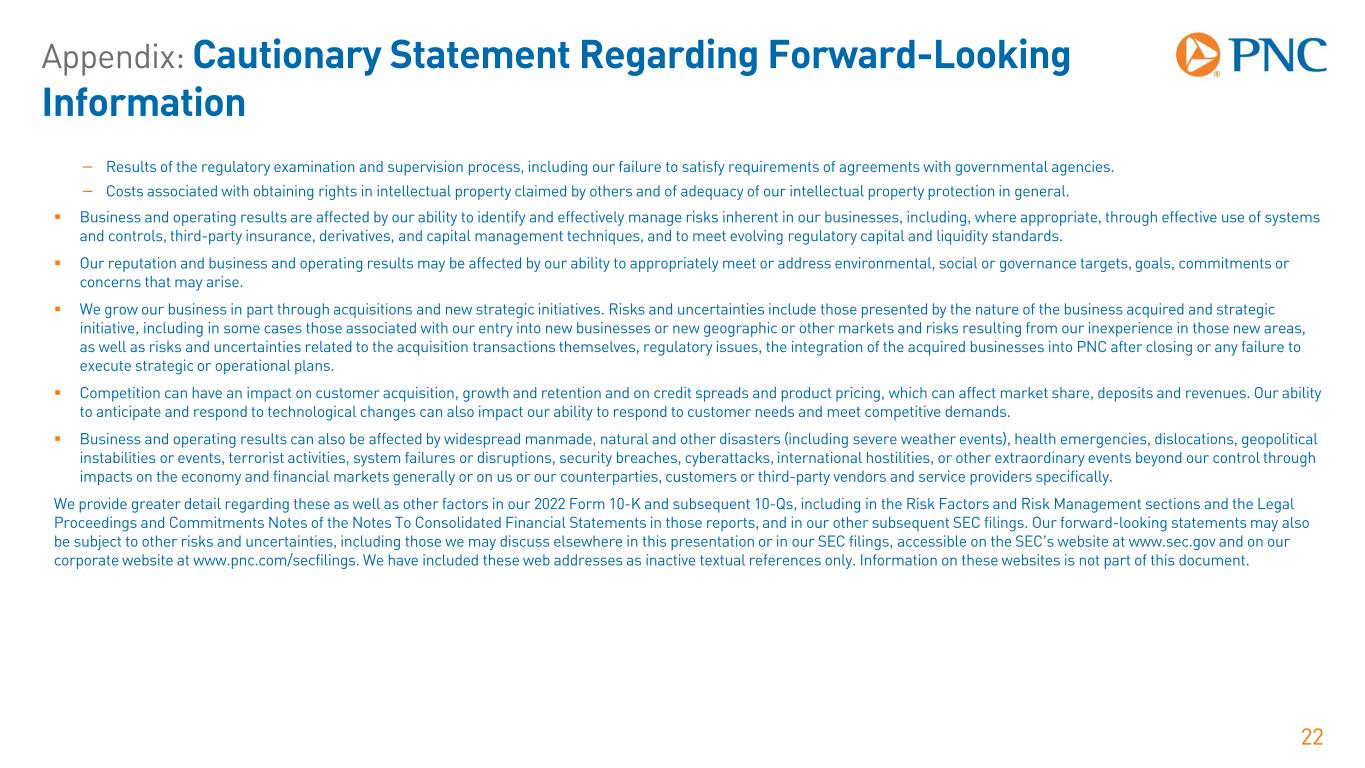
Appendix: Cautionary Statement Regarding Forward-Looking Information 22 − Results of the regulatory examination and supervision process, including our failure to satisfy requirements of agreements with governmental agencies. − Costs associated with obtaining rights in intellectual property claimed by others and of adequacy of our intellectual property protection in general. Business and operating results are affected by our ability to identify and effectively manage risks inherent in our businesses, including, where appropriate, through effective use of systems and controls, third-party insurance, derivatives, and capital management techniques, and to meet evolving regulatory capital and liquidity standards. Our reputation and business and operating results may be affected by our ability to appropriately meet or address environmental, social or governance targets, goals, commitments or concerns that may arise. We grow our business in part through acquisitions and new strategic initiatives. Risks and uncertainties include those presented by the nature of the business acquired and strategic initiative, including in some cases those associated with our entry into new businesses or new geographic or other markets and risks resulting from our inexperience in those new areas, as well as risks and uncertainties related to the acquisition transactions themselves, regulatory issues, the integration of the acquired businesses into PNC after closing or any failure to execute strategic or operational plans. Competition can have an impact on customer acquisition, growth and retention and on credit spreads and product pricing, which can affect market share, deposits and revenues. Our ability to anticipate and respond to technological changes can also impact our ability to respond to customer needs and meet competitive demands. Business and operating results can also be affected by widespread manmade, natural and other disasters (including severe weather events), health emergencies, dislocations, geopolitical instabilities or events, terrorist activities, system failures or disruptions, security breaches, cyberattacks, international hostilities, or other extraordinary events beyond our control through impacts on the economy and financial markets generally or on us or our counterparties, customers or third-party vendors and service providers specifically. We provide greater detail regarding these as well as other factors in our 2022 Form 10-K and subsequent 10-Qs, including in the Risk Factors and Risk Management sections and the Legal Proceedings and Commitments Notes of the Notes To Consolidated Financial Statements in those reports, and in our other subsequent SEC filings. Our forward-looking statements may also be subject to other risks and uncertainties, including those we may discuss elsewhere in this presentation or in our SEC filings, accessible on the SEC’s website at www.sec.gov and on our corporate website at www.pnc.com/secfilings. We have included these web addresses as inactive textual references only. Information on these websites is not part of this document.
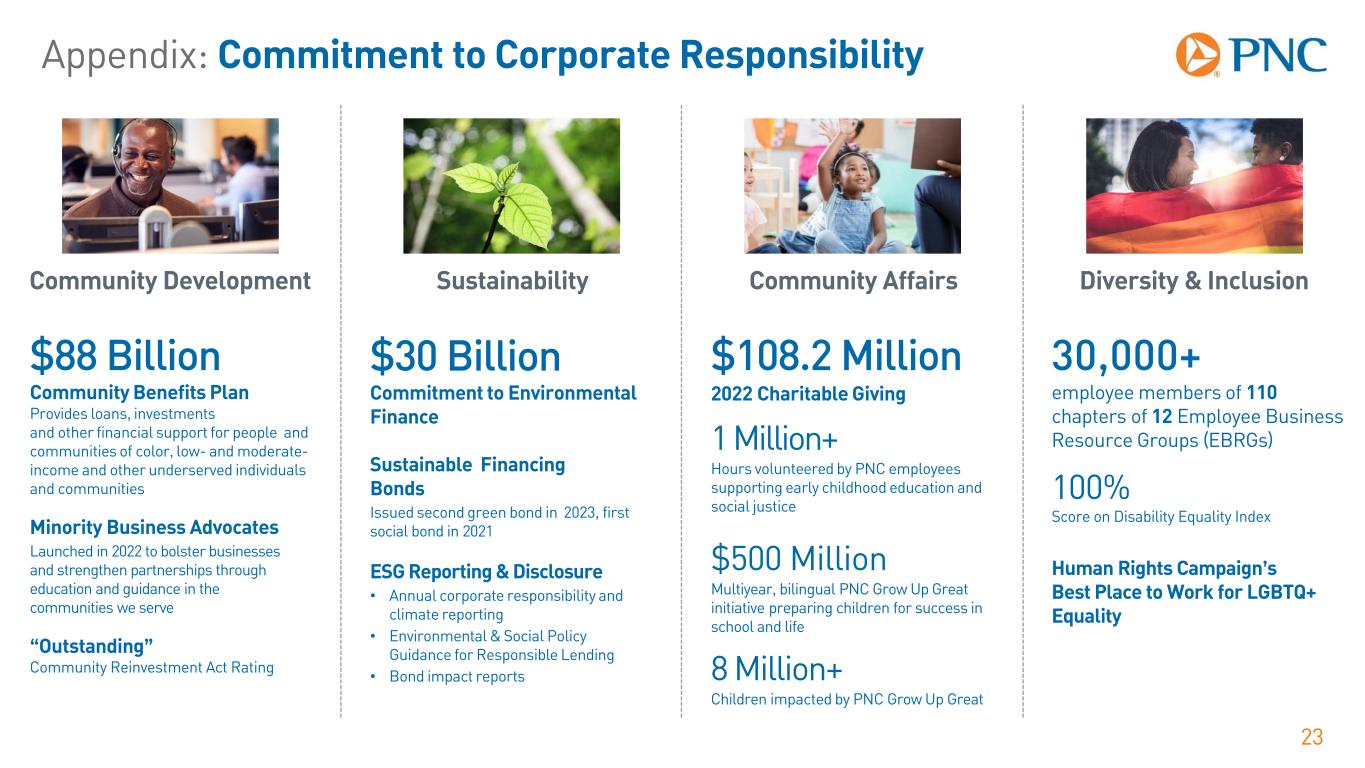
Appendix: Commitment to Corporate Responsibility 23 Community Development Sustainability Community Affairs Diversity & Inclusion $88 Billion Community Benefits Plan Provides loans, investments and other financial support for people and communities of color, low- and moderate- income and other underserved individuals and communities Minority Business Advocates Launched in 2022 to bolster businesses and strengthen partnerships through education and guidance in the communities we serve “Outstanding” Community Reinvestment Act Rating $30 Billion Commitment to Environmental Finance Sustainable Financing Bonds Issued second green bond in 2023, first social bond in 2021 ESG Reporting & Disclosure • Annual corporate responsibility and climate reporting • Environmental & Social Policy Guidance for Responsible Lending • Bond impact reports $108.2 Million 2022 Charitable Giving 1 Million+ Hours volunteered by PNC employees supporting early childhood education and social justice $500 Million Multiyear, bilingual PNC Grow Up Great initiative preparing children for success in school and life 8 Million+ Children impacted by PNC Grow Up Great 30,000+ employee members of 110 chapters of 12 Employee Business Resource Groups (EBRGs) 100% Score on Disability Equality Index Human Rights Campaign’s Best Place to Work for LGBTQ+ Equality
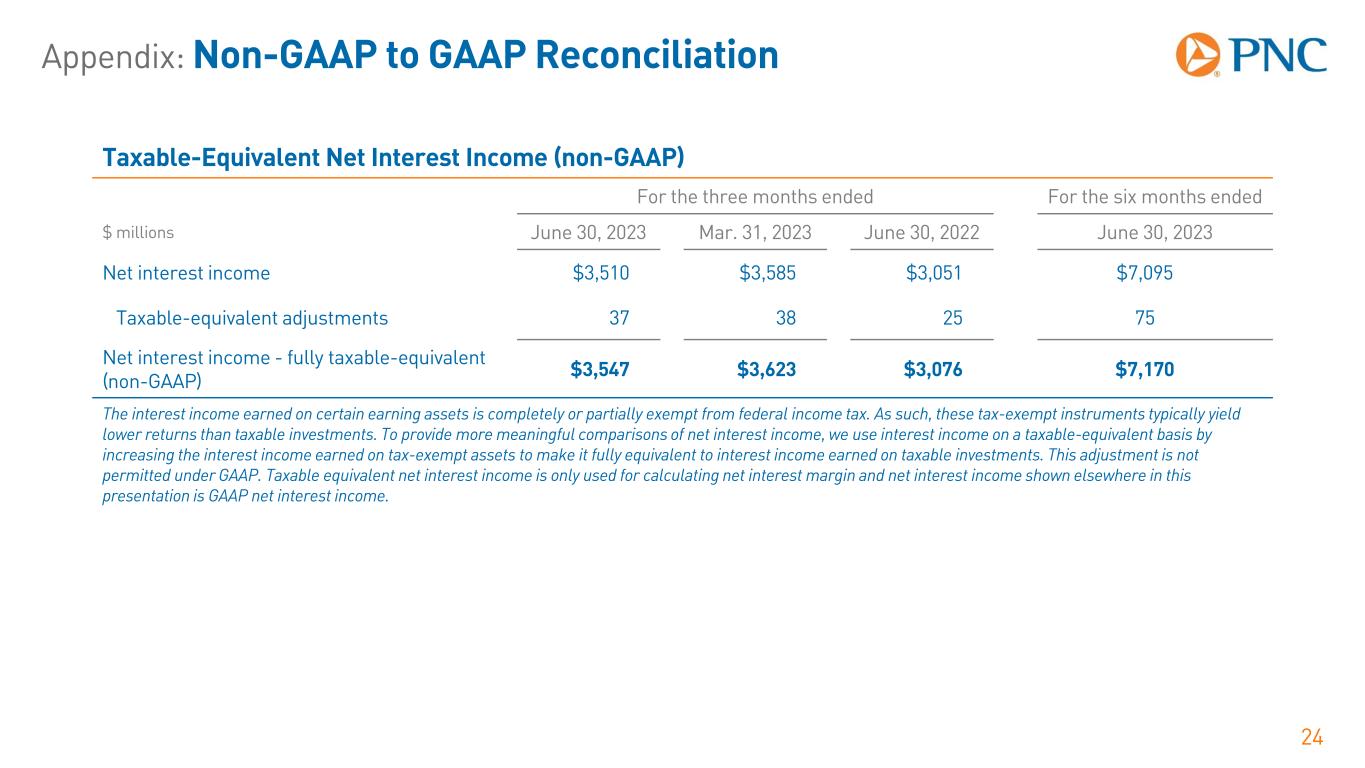
Appendix: Non-GAAP to GAAP Reconciliation 24 Taxable-Equivalent Net Interest Income (non-GAAP) For the three months ended For the six months ended $ millions June 30, 2023 Mar. 31, 2023 June 30, 2022 June 30, 2023 Net interest income $3,510 $3,585 $3,051 $7,095 Taxable-equivalent adjustments 37 38 25 75 Net interest income - fully taxable-equivalent (non-GAAP) $3,547 $3,623 $3,076 $7,170 The interest income earned on certain earning assets is completely or partially exempt from federal income tax. As such, these tax-exempt instruments typically yield lower returns than taxable investments. To provide more meaningful comparisons of net interest income, we use interest income on a taxable-equivalent basis by increasing the interest income earned on tax-exempt assets to make it fully equivalent to interest income earned on taxable investments. This adjustment is not permitted under GAAP. Taxable equivalent net interest income is only used for calculating net interest margin and net interest income shown elsewhere in this presentation is GAAP net interest income.
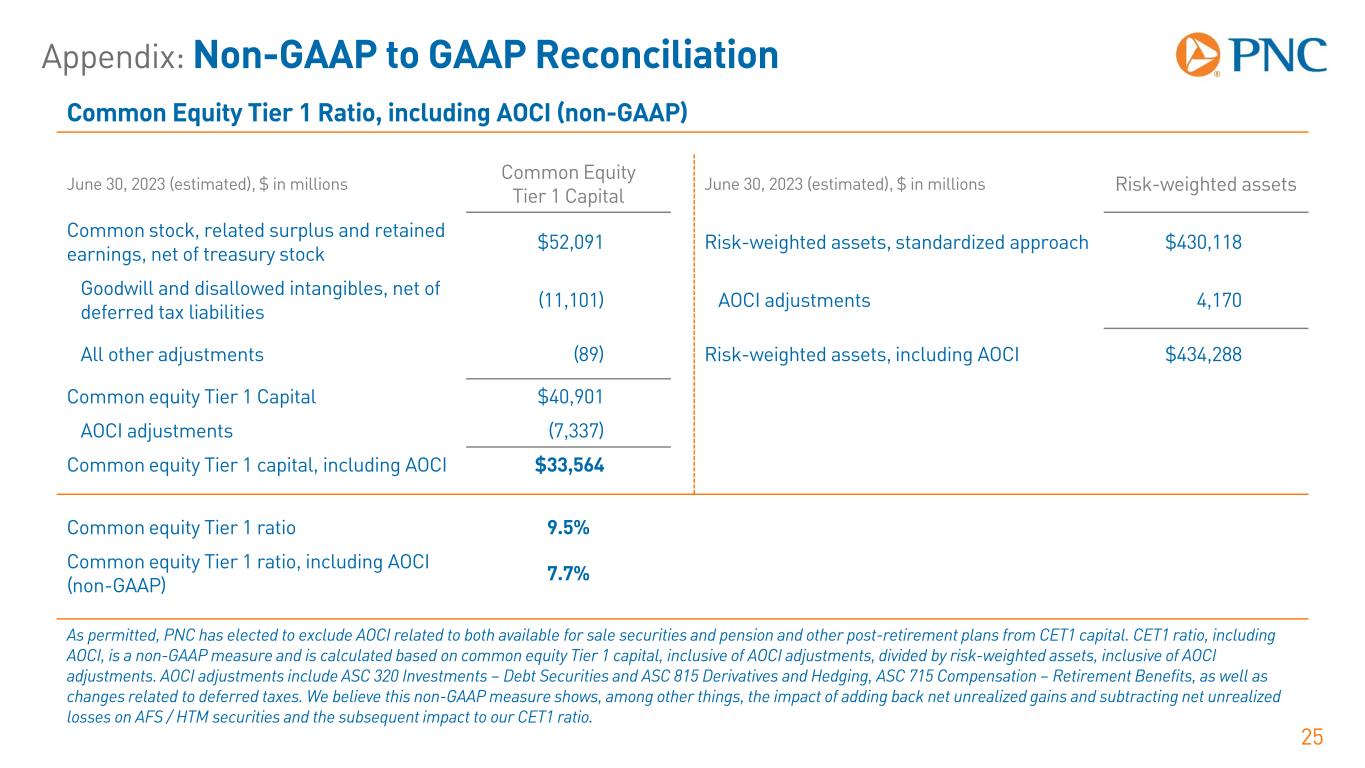
Appendix: Non-GAAP to GAAP Reconciliation 25 Common Equity Tier 1 Ratio, including AOCI (non-GAAP) June 30, 2023 (estimated), $ in millions Common Equity Tier 1 Capital June 30, 2023 (estimated), $ in millions Risk-weighted assets Common stock, related surplus and retained earnings, net of treasury stock $52,091 Risk-weighted assets, standardized approach $430,118 Goodwill and disallowed intangibles, net of deferred tax liabilities (11,101) AOCI adjustments 4,170 All other adjustments (89) Risk-weighted assets, including AOCI $434,288 Common equity Tier 1 Capital $40,901 AOCI adjustments (7,337) Common equity Tier 1 capital, including AOCI $33,564 Common equity Tier 1 ratio 9.5% Common equity Tier 1 ratio, including AOCI (non-GAAP) 7.7% As permitted, PNC has elected to exclude AOCI related to both available for sale securities and pension and other post-retirement plans from CET1 capital. CET1 ratio, including AOCI, is a non-GAAP measure and is calculated based on common equity Tier 1 capital, inclusive of AOCI adjustments, divided by risk-weighted assets, inclusive of AOCI adjustments. AOCI adjustments include ASC 320 Investments – Debt Securities and ASC 815 Derivatives and Hedging, ASC 715 Compensation – Retirement Benefits, as well as changes related to deferred taxes. We believe this non-GAAP measure shows, among other things, the impact of adding back net unrealized gains and subtracting net unrealized losses on AFS / HTM securities and the subsequent impact to our CET1 ratio.
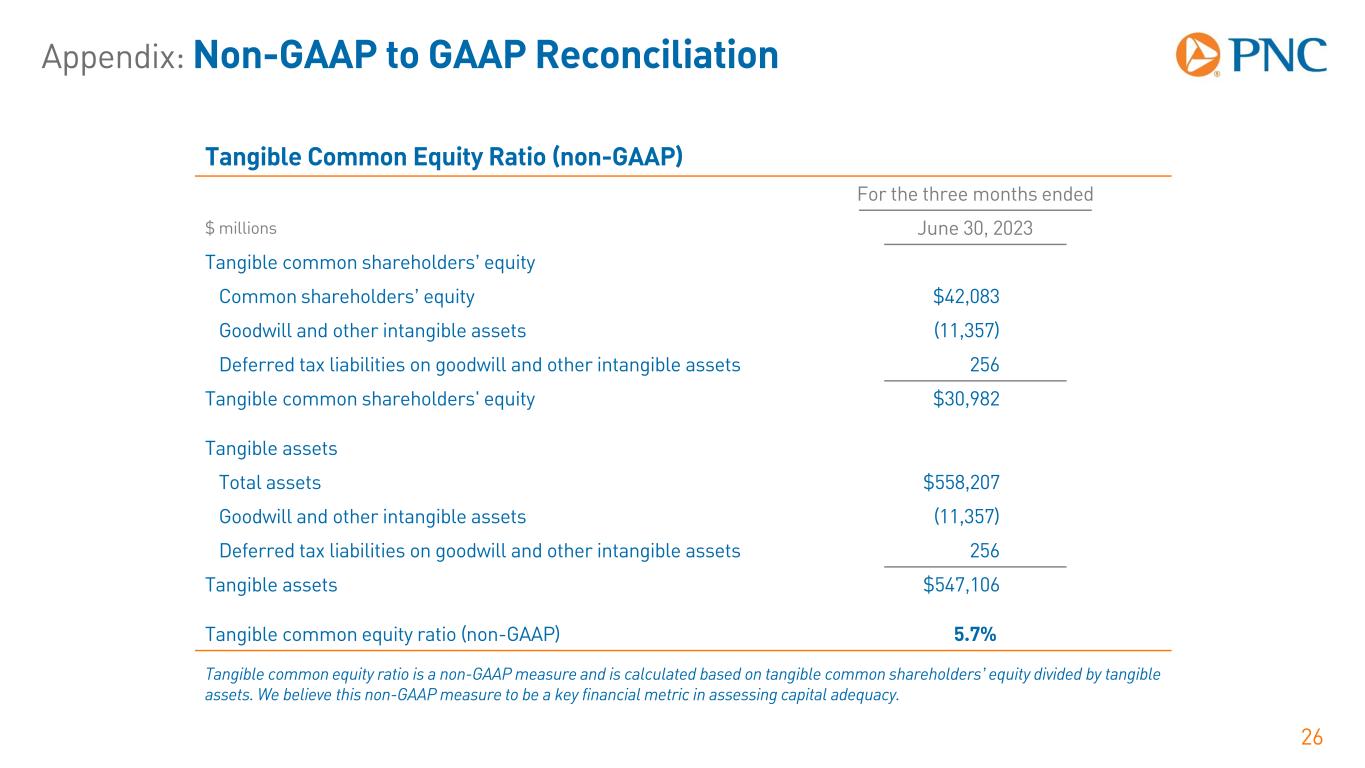
Appendix: Non-GAAP to GAAP Reconciliation 26 Tangible Common Equity Ratio (non-GAAP) For the three months ended $ millions June 30, 2023 Tangible common shareholders’ equity Common shareholders’ equity $42,083 Goodwill and other intangible assets (11,357) Deferred tax liabilities on goodwill and other intangible assets 256 Tangible common shareholders' equity $30,982 Tangible assets Total assets $558,207 Goodwill and other intangible assets (11,357) Deferred tax liabilities on goodwill and other intangible assets 256 Tangible assets $547,106 Tangible common equity ratio (non-GAAP) 5.7% Tangible common equity ratio is a non-GAAP measure and is calculated based on tangible common shareholders’ equity divided by tangible assets. We believe this non-GAAP measure to be a key financial metric in assessing capital adequacy.